
Riding the Rails. The American History Project, 1997. Written, directed, and produced by Michael Uys and Lexy Lovell. 70-minute VHS video.
"Being on the road was a humiliating experience,"
Minnesotan Jim Mitchell recalls.
Sitting on the steps of a former Civilian
Conservation Corps (CCC) camp,
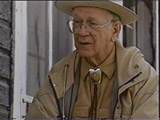 |
Jim Mitchell.
From Riding the Rails.
|
|
28.8 |
56k
|
Mitchell’s memories of riding the rails
as a 16-year-old are bittersweet. Mitchell was one of perhaps a quarter-million
teenagers who hopped freight trains at the height of the Great Depression.
Drawing from more than 3,000 letters by former transient teens,
filmmakers Michael Uys and Lexy Lovell's 70-minute video, Riding
the Rails, chronicles the motivations, survival strategies, and struggles
of teenagers who found themselves thrust (or willingly thrust themselves)
into the growing stream of migrants during the nation's worst economic
crisis. Combining Farm Security Administration (FSA) photographs, newsreel footage,
and ballads by Woody Guthrie and Jimmie Rodgers with interviews with former
teen transients, Uys and Lovell have produced a moving, sensitive, and unsentimental
documentary of life on the rails.
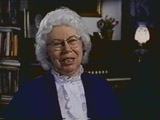 |
Peggy DeHart recalls why she
began riding boxcars in 1938. From Riding the Rails. |
|
28.8
| 56k
|
Adolescents took to the rails for a variety
of reasons. Some were forced to fend for themselves by overburdened, impoverished
families, while other, more privileged youths hopped freights for adventure.
Whatever the reason, by the early 1930s, the presence of adolescents on
freight trains had become an epidemic. Hollywood tried to discourage teens
from riding the rails, producing Wild Boys of the Road in 1933, which
depicted the dangers of such activity. For veteran freight-hopper Bob
"Guitar Whitey" Symmonds and others, however, the movie had
the opposite effect, fueling their desire to catch the next freight out
of their hometown.
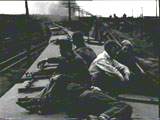 |
|
Dangers. From Riding the Rails.
|
|
28.8
|
56k
|
Once on a boxcar, many teens headed to port
cities in search of adventure and jobs. But jobs in the cities were few,
and most ended up begging on the streets and relying upon mission charity.
In smaller towns teens ran afoul of local officials who viewed them as
vagrants and drove them from the city limits. Here they joined the growing
stream of adult drifters who wandered from town to town in search of jobs
and sustenance. On the outskirts of towns, teen transients encountered
hobo camps—called "jungles"—populated by older
men and some women. Coming at about the 30-minute mark of the video,
this segment on the hobo jungles is one of the more provocative, describing
threatening, makeshift communities with random rules. Brief references
to prostitution (both hetero- and homosexual), gambling, and violence
make clear that these camps were dangerous places that teens entered at their
peril.
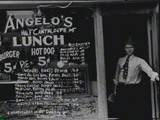 |
|
Hunger. From Riding the Rails. |
|
28.8
|
56k
|
For even the most adventurous teen, it was not long before wanderlust
and the romanticism of the train whistle and the clickety-clack of the
track were replaced by fear, regret, hunger, and loneliness. No FSA photograph
could compete with the image that one interview subject conjures of sitting
alone and sobbing on a hillside, eating a birthday cake sent by his mother.
Even 60 years later, the memory of the homesickness Clarence Lee felt
as a 16-year-old boy is sufficiently acute to cause him to break
down. They were, after all, only children.
For most of the young transients, riding
the rails would not become a way of life. "After a while," Jim
Mitchell remarks," you knew you had to get on with your life."
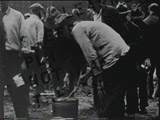 |
Hobo Jungles.
From Riding the Rails. |
|
28.8 | 56k
|
Those who found steady work abandoned the trains. Mitchell and many other young men got jobs with the CCC. Most teens returned home, and for some,
transition was difficult. Their time on the rails marked a coming of age, a turning point when they moved out of childhood and became aware of the world. Some became advocates for social change. For teen rail rider John Fawcett, raised in a middle-class family in West Virginia, his experiences during the Great Depression shaped his perceptions of the world, leading to his involvement in the labor and antiwar movements. But for many others, the pain, uncertainty, and loneliness of life on the road fostered in them a strong, but conservative, desire for steady employment and the security of home and family.
While a documentary cannot explore
all aspects of a subject thoroughly, this reviewer hoped for more analysis into the racial and gender aspects of transient life.
The narrator states that blacks riding the rails had to be wary when traveling through Southern communities, and Clarence Lee, an African American
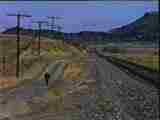 |
|
Loneliness. From Riding the Rails. |
|
28.8
| 56k
|
from Louisiana, remembers being saved by a train conductor
who put him off the train after hearing that officials in the next town were looking for a rape suspect who fit his description. But what about race relations among transients? One only has to think of the tragic events at Scottsboro, Alabama, in the 1930s—events that began as a fight between white boys and blacks boys who had jumped a freight—to wonder about the presence of hostilities among various racial groups. Similarly, the experiences of interview subject Peggy DeHart from Wyoming and the special challenges teenage girls faced go unexamined. While Jim Mitchell mentions joining the CCC, no such New Deal programs existed for young single women. Indeed, DeHart mentions that single women could not get work in Western orchards. And while all teens faced danger on the road, DeHart tells of narrowly escaping possible sexual assault or worse after she was picked up by a "couple of maniacs." My complaints aside, Riding the Rails will capture students' attention and provoke serious discussion about the choices made by people not much younger than themselves.
Kari Frederickson
University of Central Florida
~ End ~
Video Review of Riding the Rails
Copyright © 1999 by The Journal for MultiMedia History.
Comments
| JMMH
Contents
|





